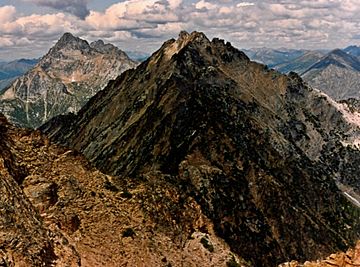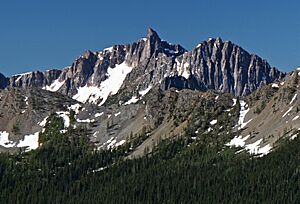Holliway Mountain facts for kids
Quick facts for kids Holliway Mountain |
|
|---|---|

Holliway Mountain seen from Golden Horn
|
|
| Highest point | |
| Elevation | 8,000 ft (2,400 m) |
| Prominence | 600 ft (180 m) |
| Geography | |
| Parent range | North Cascades |
| Topo map | USGS Washington Pass |
| Type of rock | Granite |
| Climbing | |
| Easiest route | Scrambling, class 3 |
Holliway Mountain is a tall peak, over 8,000 feet (2,400 meters) high, made of a strong rock called granite. It's found in Okanogan County, Washington state, USA. This mountain is part of the Okanogan Range, which is a smaller part of the larger North Cascades mountain range.
Holliway Mountain sits close to where the Methow River begins. It's also within the Okanogan National Forest, a protected area. The closest taller mountain is Golden Horn, about one mile (1.5 km) to the south. Another peak, Azurite Peak, is located about three miles (5 km) to the north-northwest.
Understanding Holliway Mountain's Climate
Holliway Mountain is located in a "marine west coast" climate zone. This means it gets a lot of moisture from the Pacific Ocean. Most weather fronts, which are like big air masses that bring weather changes, start over the Pacific. They then travel northeast towards the Cascade Mountains.
When these weather fronts reach the North Cascades, the tall mountains force the air to rise. As the air goes higher, it cools down and drops its moisture. This process is called Orographic lift. It causes a lot of rain or snowfall on the western side of the North Cascades. This is especially true during the winter months.
In winter, the weather is often cloudy. However, during the summer, high-pressure systems over the Pacific Ocean become stronger. This often leads to clear skies and sunny weather.
How Holliway Mountain Was Formed: Geology
The North Cascades area has some of the most rugged land in the Cascade Range. You can see jagged peaks, sharp ridges, and deep valleys carved by glaciers. These amazing landscapes and big changes in height happened because of geological events that took place millions of years ago. These events also led to the different climates we see across the Cascade Range.
The Cascade Mountains started forming millions of years ago, during a time called the late Eocene Epoch. This happened because the North American Plate (a huge piece of Earth's crust) was slowly moving over the Pacific Plate. This movement caused a lot of volcanic activity.
Also, small pieces of the Earth's outer layer, called terranes, came together. These pieces were made of both oceanic (from the ocean floor) and continental (from land) rock. They helped create the North Cascades about 50 million years ago.
During the Pleistocene period, which was over two million years ago, huge sheets of ice called glaciers moved across the land many times. As they advanced and retreated, they carved out the landscape. They left behind piles of rock and debris. The "U"-shaped valleys you see in the rivers today were formed by these glaciers.
The processes of uplift (when land is pushed up) and faulting (when cracks form in the Earth's crust and sections move) worked with glaciation. Together, they created the tall peaks and deep valleys of the North Cascades. Holliway Mountain, like many other granite peaks in the Washington Pass area, is part of a large body of granite rock called the Golden Horn Batholith.
Weather Forecast
- For the latest weather forecast, visit: Holliway Mountain




